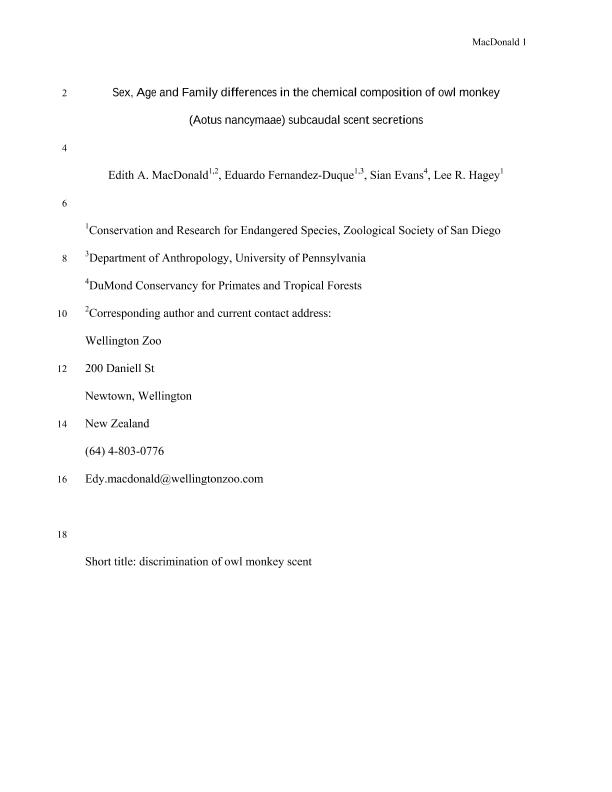Mostrar el registro sencillo del ítem
dc.contributor.author
MacDonald, Edith A.
dc.contributor.author
Fernandez Duque, Eduardo

dc.contributor.author
Evans, Sian
dc.contributor.author
Hagey, Lee R.
dc.date.available
2018-04-23T17:17:21Z
dc.date.issued
2008-01
dc.identifier.citation
MacDonald, Edith A.; Fernandez Duque, Eduardo; Evans, Sian; Hagey, Lee R.; Sex, age, and family differences in the chemical composition of owl monkey (Aotus nancymaae) subcaudal scent secretions; Wiley-liss, Div John Wiley & Sons Inc; American Journal Of Primatology; 70; 1; 1-2008; 12-18
dc.identifier.issn
0275-2565
dc.identifier.uri
http://hdl.handle.net/11336/43039
dc.description.abstract
Numerous behavioral studies have shown that animals use olfactory cues as inbreeding avoidance or kin avoidance mechanisms, implying that scent is unique to families. However, few studies have analyzed the chemical profile of a scent and ascertained the messages that are conveyed in scent secretions. Owl monkeys (Aotus nancymaae) are socially monogamous primates that utilize scent when interacting with foreign conspecifics. This suggests there is a difference in the chemical composition of scent marks. We chemically analyzed sub‐caudal gland samples from three families of captive owl monkeys (Aotus nancymaae). Samples were analyzed by capillary GC‐MS and relative retention time and fragment pattern was compared with known standards. Gland samples were high in large plant‐based shikikate metabolites and fatty ketones; alcohols, acids, and acetates were virtually absent. Gender, age, and family could be reliably classified using discriminant analysis (92.9, 100, and 100%, respectively). Female scent profiles were greater in concentration of aromatic plant metabolites, possibly the result of a different diet or physiological differences in female metabolism as compared to male. Offspring of adult age still living in their natal group showed a less complex chemical profile than their parents. Finally, each family had its own unique and complex chemical profile. The presence of family scent may play a role in mediating social interactions. Am. J. Primatol. 70:12–18, 2007. © 2007 Wiley‐Liss, Inc.
dc.format
application/pdf
dc.language.iso
eng
dc.publisher
Wiley-liss, Div John Wiley & Sons Inc

dc.rights
info:eu-repo/semantics/openAccess
dc.rights.uri
https://creativecommons.org/licenses/by-nc-sa/2.5/ar/
dc.subject
Olfaction
dc.subject
Scent Analysis
dc.subject
Primate
dc.subject
Chemical Communication
dc.subject
Scent Mark
dc.subject.classification
Otras Ciencias Biológicas

dc.subject.classification
Ciencias Biológicas

dc.subject.classification
CIENCIAS NATURALES Y EXACTAS

dc.title
Sex, age, and family differences in the chemical composition of owl monkey (Aotus nancymaae) subcaudal scent secretions
dc.type
info:eu-repo/semantics/article
dc.type
info:ar-repo/semantics/artículo
dc.type
info:eu-repo/semantics/publishedVersion
dc.date.updated
2018-04-16T13:45:48Z
dc.journal.volume
70
dc.journal.number
1
dc.journal.pagination
12-18
dc.journal.pais
Estados Unidos

dc.journal.ciudad
New York
dc.description.fil
Fil: MacDonald, Edith A.. Zoological Society of San Diego; Estados Unidos
dc.description.fil
Fil: Fernandez Duque, Eduardo. Zoological Society of San Diego; Estados Unidos. University of Pennsylvania; Estados Unidos. Consejo Nacional de Investigaciones Científicas y Técnicas; Argentina
dc.description.fil
Fil: Evans, Sian. DuMond Conservancy for Primates and Tropical Forests; Estados Unidos
dc.description.fil
Fil: Hagey, Lee R.. Zoological Society of San Diego; Estados Unidos
dc.journal.title
American Journal Of Primatology

dc.relation.alternativeid
info:eu-repo/semantics/altIdentifier/doi/http://dx.doi.org/10.1002/ajp.20450
dc.relation.alternativeid
info:eu-repo/semantics/altIdentifier/url/https://onlinelibrary.wiley.com/doi/abs/10.1002/ajp.20450
Archivos asociados
